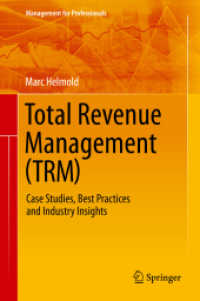- ホーム
- > 洋書
- > 英文書
- > Science / Mathematics
Full Description
This textbook is designed for teaching quantitative research in the scientific, health and engineering disciplines at first-year undergraduate level, with an emphasis on statistics. It covers the research process, including asking research questions, research design, data collection, summarising data, analysis and communication. Many real journal articles are used throughout the text as examples that demonstrate the use of the techniques.
Students are introduced to statistics as a method for answering questions. Descriptive research questions lead to analysis of single proportions and means. Repeated-measures research questions are answered using paired quantitative data. Relational research questions compare proportions, odds and means in different groups. Correlational research questions are studied using correlation and regression techniques.
Statistical topics include numerical summary methods (such as means, odds ratios and identification of outliers), graphing (such as histograms, case-profile plots and scatterplots), confidence intervals and hypothesis testing. Emphasis is placed on understanding and concepts; while calculations are shown in simple situations, they are deferred to software when the computations become tedious and disruptive to understanding.
Almost every dataset used is a real dataset, and is available online or in an associated R package SRMData. Software output is often used when calculations become onerous. The output is sufficiently generic that the book can be used in conjunction with any statistical software.
Contents
Preface 1. Research: an introduction Part I. Asking research questions 2. Research questions Part II. Research design 3. Overview of research design 4. Types of research studies 5. Ethics in research 6. External validity: sampling 7. Internal validity 8. Research design limitations Part III. Collecting data 9. Collecting data Part IV. Classifying and summarising data 10. Classifying data and variables 11. Summarising quantitative data 12. Summarising qualitative data 13. Comparing quantitative data within individuals 14. Comparing quantitative data between individuals 15. Comparing qualitative data between individuals 16. Correlations between quantitative variables 17. More details about tables and graphs Part V. Tools for answering RQs 18. Probability 19. Sampling variation 20. Models and normal distributions Part VI. Analysis 21. Introducing inference 22. Confidence intervals: one proportion 23. Confidence intervals: one mean 24. More details about CIs 25. Making decisions 26. Hypothesis tests: one proportion 27. Hypothesis tests: one mean 28. More details about hypothesis testing 29. CIs and tests: mean differences (paired data) 30. CIs and tests: comparing two means 31. CIs and tests: comparing two odds or proportions 32. Finding sample sizes for CIs 33. Correlation and regression 34. Selecting an analysis Part VII. Reporting and reading research 35. Reporting and writing research 36. Reading and critiquing research Appendix A. Datasets B. □□-score tables C. Symbols, formulas, statistics and parameters Glossary Answers to odd-numbered exercises Bibliography Index








